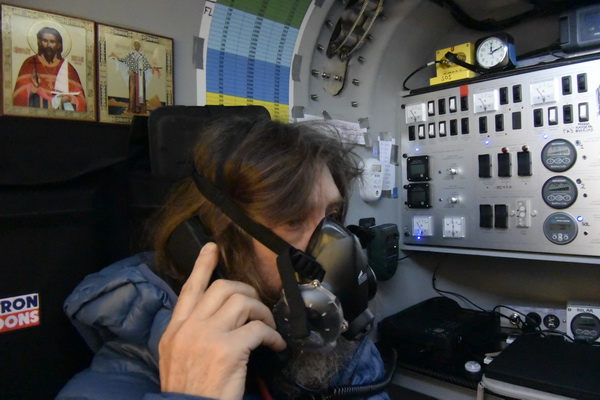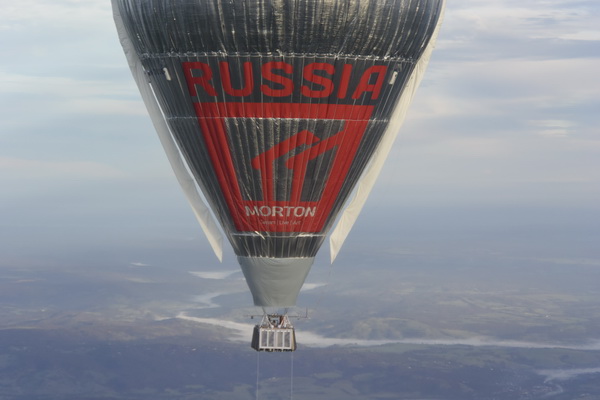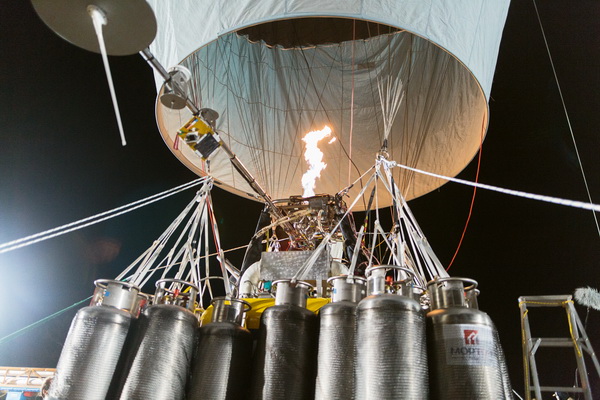Flying over the ocean

Morton balloon has crossed the longitude of 163 degrees east and is currently flying in New Zealand airspace. Last night, the pilot Fedor Konyukhov left the Green continent in the hopes of circumnavigating the globe and returning to welcoming Australian soil. When Fedor was crossing the coast, air traffic controllers farewelled him on their radio frequency and said: “good luck, Fedor”. An hour later, the balloon flew over Lord Howe island. Currently, the ground crew is keeping in touch with air traffic controllers in New Zealand (Auckland). We received permission to fly at FL 260 (26,000 feet) or 7,924 meters. We are satisfied with this flight level for today.
Now that the Morton balloon is over the ocean, we have the opportunity to take a breath and look back at the 3 day and 5000 km long flight. We will also try to answer some questions that we received here at the Flight Control Centre.
Why was Fedor flying at the height of 6,700-7,000 meters during the first few days? The media announced a flight level of 8,000 meters…
These flight levels have been calculated on the basis of the maximum take-off weight of the balloon (MTOW), at 9762 kg. In order to rise above 7,000 meters on the first day (for example to 8,000 meters) we had to leave behind a few fuel cylinders (filled with propane) to the equivalent of 5 days of flying.
Morton balloon took off with the maximum fuel load of 35 steel cylinders of propane. Total fuel weight was 5,355 kg.

How is the weight of fuel calculated?
Breakdown of the fuel weight: each steel cylinder weighs 49 kg. The cylinder is pumped with 94 kilograms of propane gas. In addition, about 10 kg of ethane is pumped into each cylinder. Ethane is added to propane for the purpose of improving the overall saturation vapour pressure of the gas mixture, in order to avoid reducing the gas pressure in the cold (Morton balloon flies in sub-zero temperatures at all times). So, the total weight of each cylinder is 153 kg (with small tolerances) x 35 = 5,355 kg.
What are technical parameters for the gas envelope? How heavy is the shell?
A fully assembled shell weighs 1, 628 kg. The volume of the gas compartment is 15, 575 cubic meters. 60% of the volume of the gas envelope has been filled with helium just before the start. Considering the height, when heated by the sun the helium considerably increases in volume, so the pressure inside the balloon is formed. Excess helium is automatically pitted through appendices (the sleeves on both sides of the ball). At the start we pumped in approximately 9,700 cubic meters of helium.
Buoyancy of helium is as follows: 1 m³ of helium lifts 1 kg of weight. At night before the start our team pumped helium until the balloon reached the state of equilibrium (the state of equilibrium is when the balloon does not rise, but is not touching the ground). At dawn Fedor ignited the burners and the balloon journeyed into the sky.

Photo: Morton
Why so many cylinders?
For the first leg of the trip, just to cross the Pacific (from Australia to Chile) Fedor would have only required a quarter of his current propane stock as you could fairly accurately predict the height and strength of the jet stream for most of this route. However, Fedor endeavours to fly around the world. Due to this huge distance many uncertainties lay ahead of him.
No meteorologist or computer model can forecast the speed or direction of the wind when flying a route of 30,000+ km. Weather forecasts are reliable up to 5 days maximum. We will not be able to avoid unexpected changes in velocity. Therefore, Fedor will not be able to fly around the world in a single jet stream.
(A brief note from Alex Vikulov, a member of Fedor Konyukhov’s expedition HQ and a former BoM meteorologist: “Jet streams are fast generally westerly air currents found in the upper troposphere. They are constantly meandering, may develop and dissipate, split in two or more streams, combine into one stream and even develop closed circulation eddies”.)
Estimated fuel consumption is 1.5 cylinders per day. So, the total fuel reserve gives Fedor 23 days of flying. Currently Fedor is on track in regards to our fuel consumption estimate.
Previously there were only two successful around the world balloon flights:
One took place in the Northern Hemisphere in 1999 and it took them 21 days to complete the flight (two pilots).
The other took place in the southern hemisphere in 2002 and it took him 13 days (one pilot).
We hope for the best but are prepared for any situation. Our estimates were based on a conservative scenario. The first three days over Australia have demonstrated that our conservative approach to fuel reserves was accurate.

Photo: Morton
Could you have revised the launch window?
No. A huge shell, consisting of three sections, has been assembled and filled without fail. The lift-off of the balloon was executed perfectly. The climb happened according to plan. The pilot has tested all systems during the first two days of flying. Everything has now been fixed and calibrated. Australia astern. Fedor is flying over the Pacific Ocean with New Zealand on his starboard side, at a current height of 7500 meters and speed of 130 km per hour.
Greetings.
Oscar Konyukhov.
Headquarters of the expedition.
Northam, Western Australia
Translated by Alex Vikulov
You can follow the balloon’s path here: https://my.yb.tl/RRTW2016
You can also view the route map at www.iridium360.ru
The official website for the project “Around the world in a Roziere balloon “Morton” can be found at a flyfedor.ru